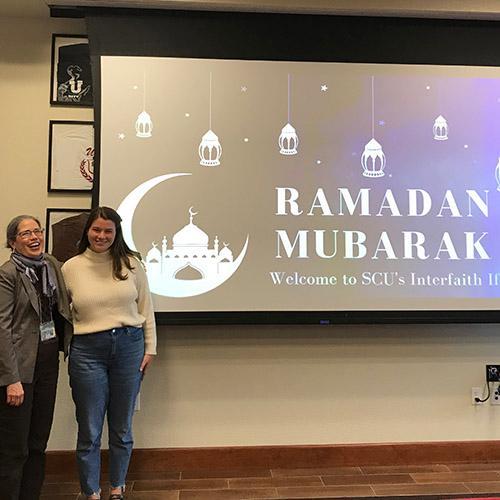
Religious Studies Major Olivia Hill and Faculty Member Sarita Tamayo-Moraga present at AARWR
On March 2, 2019, sophomore Olivia Hill (major in Religious Studies) and Prof. Sarita Tamayo-Moraga (Senior Lecturer in Religious Studies) gave a presentation at the American Academy of Religion Western Region (AARWR) conference in Phoenix, AZ on the pedagogy of the RSOC 9 "Ways of Understanding Religion" class that is linked to the Imagine interfaith/belief floor in Unity Residential Learning Community (RLC) and to Campus Ministry. The paper was entitled “Pedagogical Practices for Working with Emotional Resistance as a Method for Deepening Learning and Cultivating Stability in a First Year Religious Studies Course” and was included in the Education and Pedagogy Unit of the AARWR.
Report from Sarita Tamayo-Moraga
The theme of the conference was the exploration of the intersection of religion and resistance. Our paper explored how the pedagogies and assignments used in the Unity RLC RSOC 9: “Ways of Understanding Religion” teach students how to resist internal and external stereotypes in relation to the academic study of religion. Olivia and I focused on how this resistance is taught in order to help students resist hatred and stereotypes specific to religion. The process of learning how to resist these internal and external stereotypes was then linked to the way in which this resistance leads to deep learning because once the students are able to identify their adoption of stereotypes, they can begin to detach from them and instead see what is actually in front of them.
We paid special attention to the way the neighbor pedagogy (turning the stranger into the neighbor) and assignments attempted to aid in resisting the national rhetoric that Muslims cannot be American and the persistent harmful rhetoric that all Muslims are terrorists or potential terrorists. In tandem with the above, special attention was paid to the stereotypical idea that one’s own religion, in particular, Christianity, can do no wrong and how the pedagogy and assignments can aid the students in resisting both internal and external stereotypes. AY 2018-2019 was the fourth year of the Imagine Interfaith/belief RSOC 9.
Olivia Hill presented on her own experience in the RSOC 9 class of Fall 2017 when she herself lived on the Imagine floor in Unity RLC. She then was the peer educator for the same class in Fall of 2018. Olivia was in the third incarnation of the Imagine RSOC 9 and was peer educator for the fourth incarnation of the class/community in Fall of 2018. In addition, Olivia and I both live in the Unity Residential Learning Community, whose theme is diversity as a catalyst for civic engagement. I am the Faculty Director of the hall and Olivia is a Community Facilitator (elsewhere known as Resident Assistant) and she is the Interfaith Intern for Carly Lynch, Director of Religious Diversity in Campus Ministry. The Imagine floor inside the hall consists of the 28 students who take the Fall version of the RSOC 9 class. Thus, we all live together and learn together. What follows is a brief summary of Olivia’s own experience of giving the paper at AARWR 2019.
Report from Olivia Hill
In my part of the presentation, I reflected upon my own religious experience, growing up in a Southern Baptist family and eventually confronting my own Islamophobia, and connected it to various aspects on the Imagine floor experience. I discussed the overall pedagogy of resistance to stereotypes in the Ways of Understanding Religion class, the writing of Eboo Patel (which we read in RSOC 9), journal assignments, service experiences, and justice-oriented programming within the larger Unity community, all of which contributed to my personal growth and transformation.
In the weeks leading up to the conference, I worked closely with Prof. Tamayo-Moraga in an independent study course in Winter of 2019 and I was able to develop my presentational skills, which have continued to be of use to me throughout this year and, I’m sure, beyond. The conference was a very positive experience for me; it was one of the first times I was placed in a professional setting with Religious Studies academics, all of whom were supportive of our presentation and further work. I was inspired and encouraged by the research of other presenters, and this opportunity has given me a taste of where I take my Religious Studies degree after Santa Clara and what current research and study in the field looks like.
Finally, my supervisor for my interfaith internship in Campus Ministry, Carly Lynch, SCU’s Director of Religious Diversity in SCU Campus Ministry, was just awarded a grant from the Interfaith Youth Core for the development of an Interfaith Council on SCU’s campus and I am sure our work on the Imagine floor will inform the creation and development of an Interfaith Council on SCU’s campus. I am sincerely very grateful to the department for supporting our participation in the conference; this experience was invaluable.